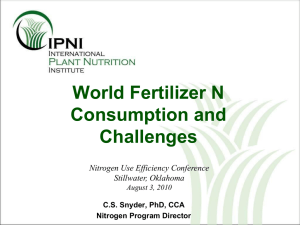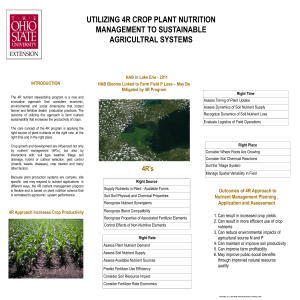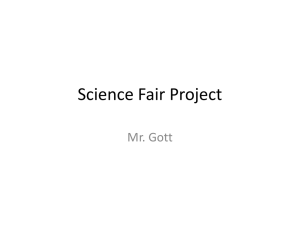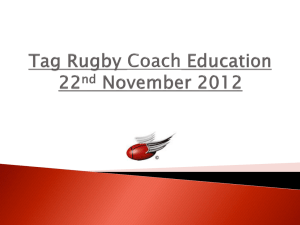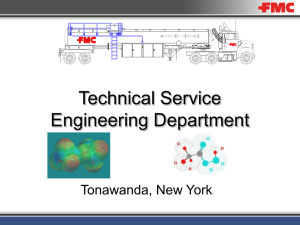IPNI-North American 4R Research Fund
advertisement
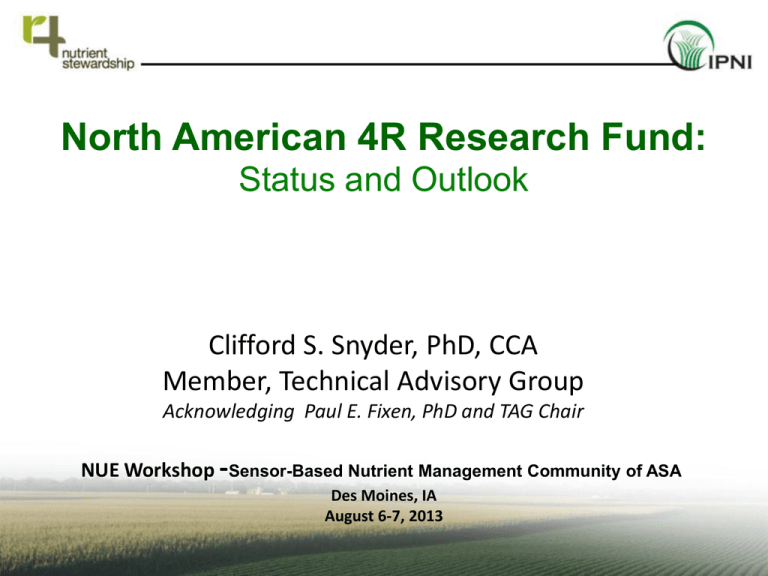
North American 4R Research Fund: Status and Outlook Clifford S. Snyder, PhD, CCA Member, Technical Advisory Group Acknowledging Paul E. Fixen, PhD and TAG Chair NUE Workshop -Sensor-Based Nutrient Management Community of ASA Des Moines, IA August 6-7, 2013 Current Regional N & P projects in NA with IPNI support • N source evaluation and management – – – – – • Evaluation of P and N Fertilizers Treated with Polymer Additives to Increase Fertilizer Efficiency – AB Evaluation of Fertilizer Application Uniformity and Nutrient Distribution – AL http://www.ipni.net/researchdatabase Improving Accuracy of Nutrient Removal Estimates - MO Nutrient Removal by Fruit & Vegetable Crops in Texas – TX Biomass & Macronutrient Accumulation & Losses in Switchgrass During & After the Growing Season – AR Comparative Nutrient Use Efficiency by Candidate Biofuel Crops – IN Documenting Nutrient Deficiency & Accumulation Rate in Vegetables – TN Improving soil test calibration – – – • Investigating Corn Hybrid Interactions with N and Foliar Fungicides – ON N Fertilization Methods for No-till Cropping of Winter Wheat in Central Montana – MT Improving N Fertilizer Management in Surface-irrigated Cotton – AZ Global Maize Project in the United States – IA, IN, MN, VA Improving prediction of crop P rate needs - removal and efficiency – – – – – • Nitrous Oxide Emissions from the Application of Fertilizers: Source Partitioning – CA A Micrometeorological Study to Quantify NH3 Volatilization Losses from Surface Applied Urea in the Semiarid NGP – MT Contribution of AFOs and Synthetic Fertilizers to NH3 Deposition in Rocky Mountain National Park – CO P source evaluation and management – – • Do we really need another industry based research fund? N interactions and efficiency in cropping systems – – – – • Beta-testing the Adapt-N Tool in On-farm Strip Trials – NY N Rate Study for Potato Production in Northeast Florida – FL Long-term Optimum N Rates for Corn Yield and Soil Organic Matter in Ontario – ON N Recalibration for Corn in North Dakota – ND Interaction of N Management, Hybrid Selection and Population in Corn Production – NE, ND, MO Improving understanding of N losses to the environment – – – • K, secondary, and micro studies excluded Improving prediction of crop N rate needs – – – – – • Large Urea Granules for Broadcast Application for No-till Cropping – AB Large Urea Granules for Broadcast Application in Perennial Forage Grasses – AB Evaluation of Urea N Fertilizer Treated with a Polymer Additive to Increase Fertilizer Efficiency – SK Evaluation of Ammonium Sulfate Nitrate in Virginia Snap Bean Production – VA Evaluation of Ammonium Sulfate Nitrate in Virginia Sweet Corn Production – VA Soil Test P Level and Yield Potential - NE Effect of Long-Term N, P, and K Fertilization of Irrigated Corn and Grain Sorghum - KS Soil Testing Verification in the Fall River Valley, Northeastern California – CA Crop P management and interactions – – – – – Mineral Nutrition of Leafy Lettuce and the Impact on Verticillium Severity – CA Applied Fertility Management for Irrigated Soybean Production – KS K and P Fertilization of Grass Pastures – FL Loblolly Pine Stand Fertilization at Mid-Rotation to Increase Small & Large Sawtimber Volume – GA Soil Fertility Management for High Population, Narrow Row Corn Production – NC • The scientific principles behind the 4Rs and the practices that support them have been documented in the IPNI manual based on decades of research by the scientific community • However, research gaps exist in applying these principles in meeting contemporary challenges facing agriculture – Plot or field results often disconnected from larger scale impacts of greatest concern to stakeholders Measured and estimated size of the hypoxic zone from 1979 to 2012 and the predicted size for 2013 measured size in 2013 HAP is the goal of the Hypoxia Action Plan by 2015 Are we comfortable with this and with our ability to respond? Can we connect in-field practices with downstream impacts? Rabalais & Turner, 6/18/2013 4R Research Fund Structure 4R Research Fund Management Committee (FMC) Voting Members AgriServices of Brunswick – Bill Jackson Agrium – Doug Beever CF Industries – Rosemary O’Brien CHS – Michael Johnson J. R. Simplot – John Malinowski Potash Corp – Jeff Holzman Richardsons – Steve Biggar The Mosaic Company – Mark Kaplan United Suppliers – Jeff Carr Willard Ag – Billy Willard Ex-Officio Members CFI – Clyde Graham IPNI – Terry Roberts TFI – Lara Moody (Chair) USDA Natural Resources Conservation Service – Tom Christianson USDA Agricultural Research Service – Mark Walbridge 4R Research Fund Technical Advisory Group (TAG) Private Industry Universities Dr. Greg Binford, Wilbur-Ellis Dr. Tim Hartz, Univ. of California-Davis Dr. Howard Brown, GROWMARK Dr. Matt Helmers, Iowa State Univ. Dave Coppess, Heartland Coop Dr. Ivan O’Halloran, Univ. of Guelph Dr. Kyle Freeman, Mosaic Company Dr. Rigas Karamanos, Viterra Alexandre Mailloux, La Coop Federee Dr. Robert Mullen, Potash Corp Dr. Steve Petrie, Yara NA Dr. Terry Tindall, J.R. Simplot Dr. Greg Schwab, Koch Federal Dr. Cynthia Grant, AAFC Dr. Daren Harmel, USDA-ARS Dr. Newell Kitchen, USDA-ARS Dr. Peter Kleinman, USDA-ARS Shannon Zezula, USDA-NRCS Dr. Yebin Zhao, CF Industries Other International Plant Nutrition Inst. Melissa Bauer, B&M Crop Consulting Dr. Paul Fixen, IPNI (Chair) Dave DeGeus, The Nature Conservancy Dr. Cliff Snyder, IPNI Gail Hesse, Ohio Lake Erie Ex-Officio Lara Moody, TFI Kristian Stephens, CFI Jean Payne, IL Fertilizer & Chemical 4R Fund activity to date • Contributions: – Goal: $1.4 to 2 M/year – Received in 2013: $1.1M plus • Technical Advisory Group – Met in Chicago on May 20 • Fund Management Committee – Met via conference call on June 17 4R Research Fund objectives as recommended by the TAG and revised/approved by the FMC • Quantify potential environmental, economic and social impacts resulting from combinations of source, rate, time and place decisions. Research measures and procedures utilized should: – for each treatment or system, justify source, rate, time and place aspects whether or not they are directly evaluated; – focus on commercial fertilizers; – relate impacts to those for traditional or baseline practices in comparable geographies while considering the potential for broader application; – emphasize high productivity systems (per unit area per unit time) for the region evaluated. 4R Research Fund objectives as recommended by the TAG and revised/approved by the FMC • Quantify potential environmental, economic and social impacts resulting from combinations of source, rate, time and place decisions. • Develop and populate an open access 4R Fund data repository that will enable use of 4R data in models (e.g. APEX, EPIC, DAYCENT, DNDC, SPARROW, .etc.) used by USDA, EPA, USGS, and others; and • Integrate, publish and disseminate new research results and pre-existing knowledge to educate stakeholders on the environmental, social and economic benefits/impacts of 4R management. Stakeholders include farmers/ranchers, the fertilizer industry, extension, researchers, regulators, policy makers, the food industry, and consumers. Project priorities and protocols • Discussion initiated but not completed by TAG – High priority to: • Definition of essential data to be collected • Literature syntheses taking advantage of existing synthesis products – Identify critical gaps – Potential topics are being identified • Survey of existing practices in key regions for baseline establishment – Develop narrowly focused RFPs (general call or solicited) – Look for opportunities where field efforts are underway • Committees established – Meta-analyses – Baseline Surveys – Canadian projects Canadian projects • Agriculture and Agri-Food Canada’s AgriInnovation research grant program – Part of Canada’s version of the US Farm Bill – Offers a 3:1 match for industry cash; Deadline of 6/30/2013 • Five proposals (3 N, 2P) passed on to the 4R Fund TAG from CFI – 4R Fund request of $656,000 over 5yrs ($131,000/yr) – With AAFC match totals to $2.5M ($500,000/yr) • TAG recommended that the FMC: – grant CFI permission to advance the set of proposals to AAFC to meet the June 30 deadline, provided that … – dialogue continue with the researchers to refine the projects before funding decisions are made later this year • FMC supported the TAG recommendation Next steps • FMC will meet in late September at TFI World Fertilizer Conf. • TAG has been asked to have recommendations for RFPs or specific projects ready for the September meeting • Breakfast meeting of TAG members at Nutrient Stewardship Summit in Des Moines, IA on June 26 Now is a great time to offer input to TAG members





